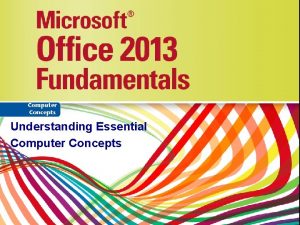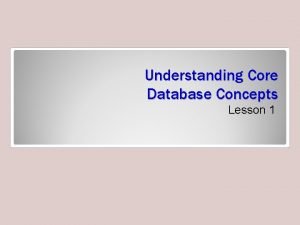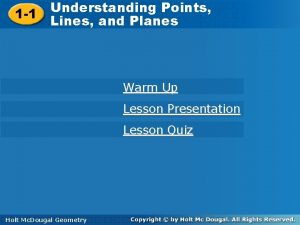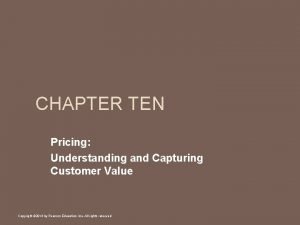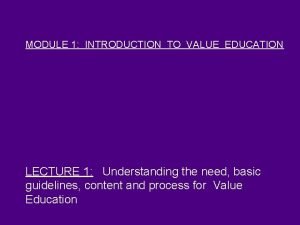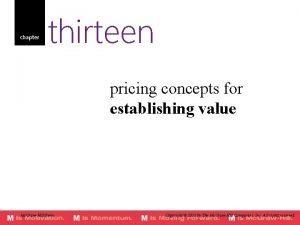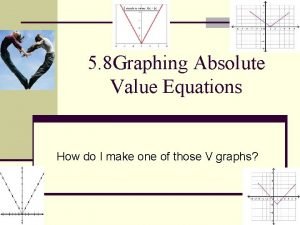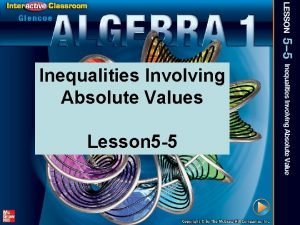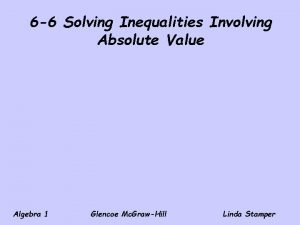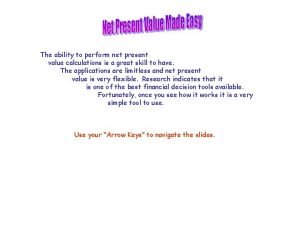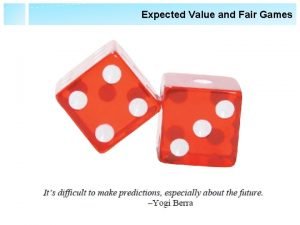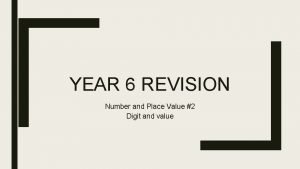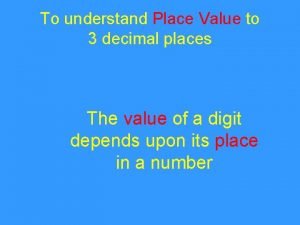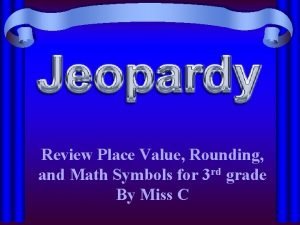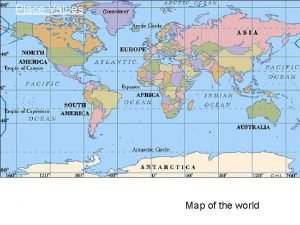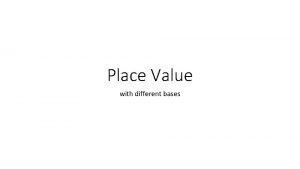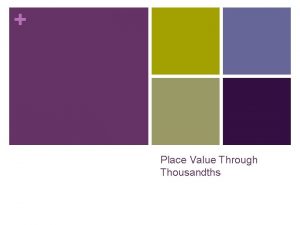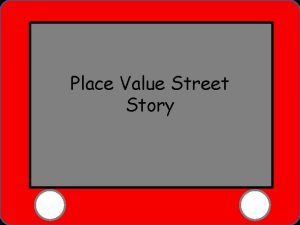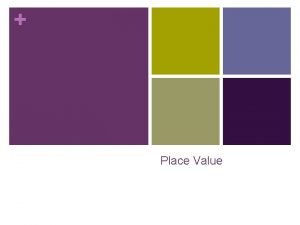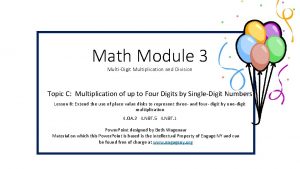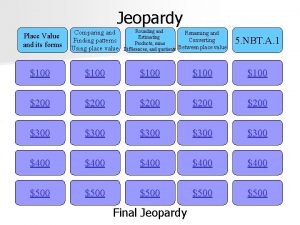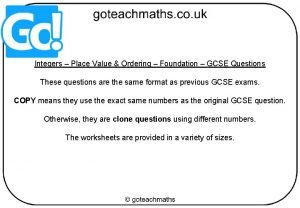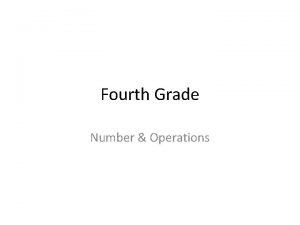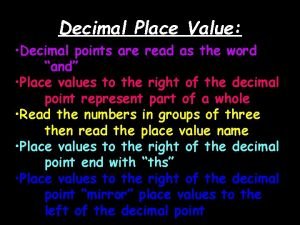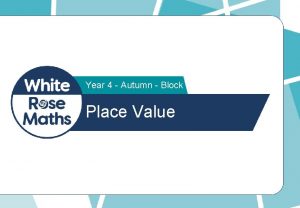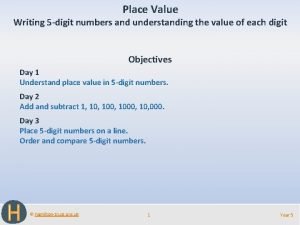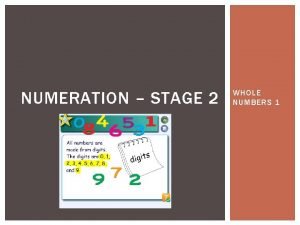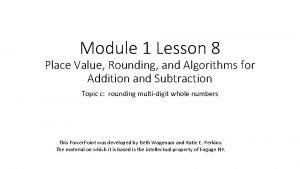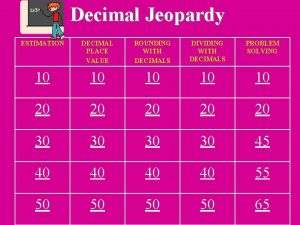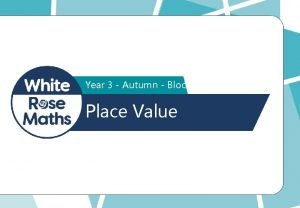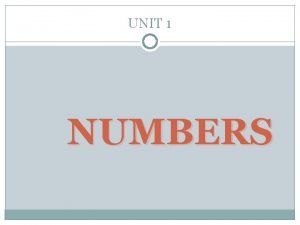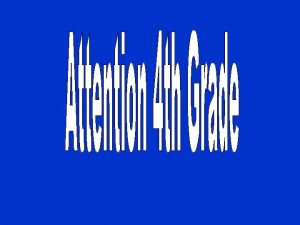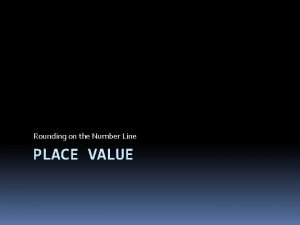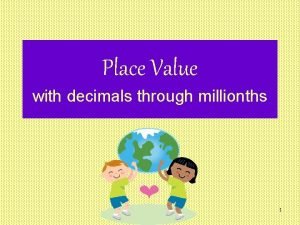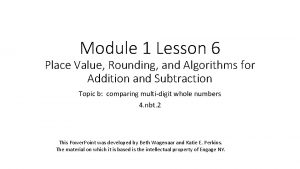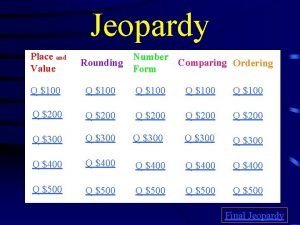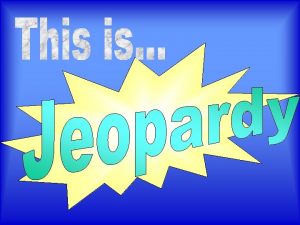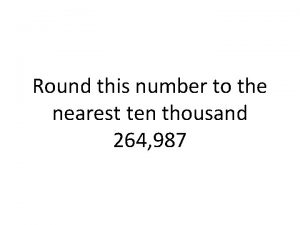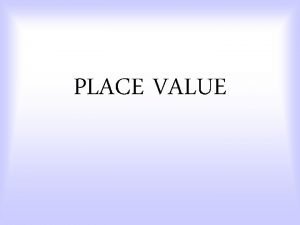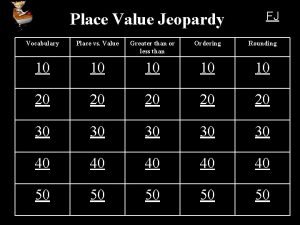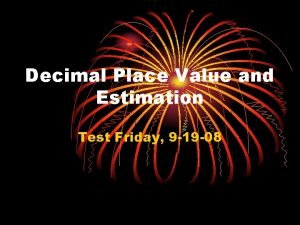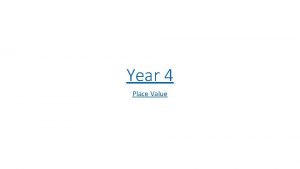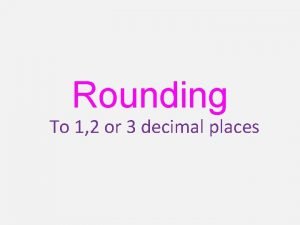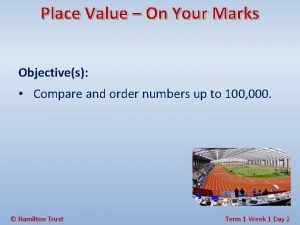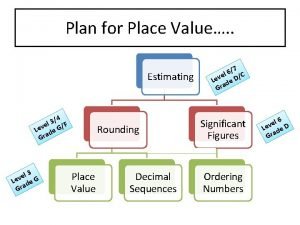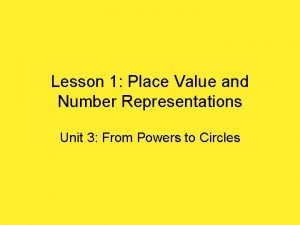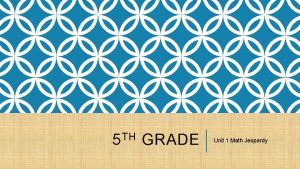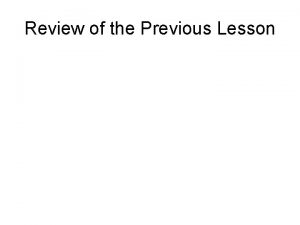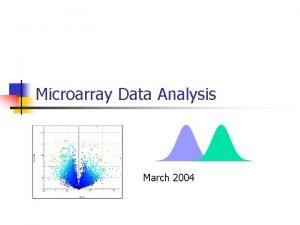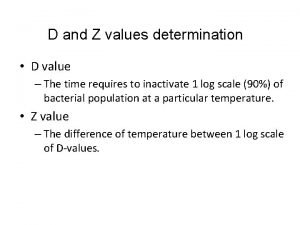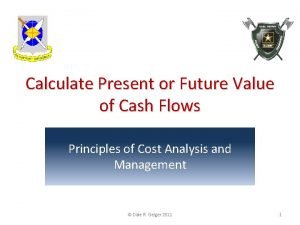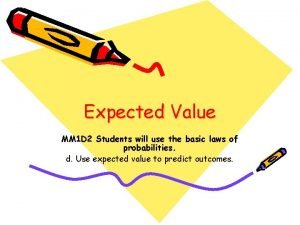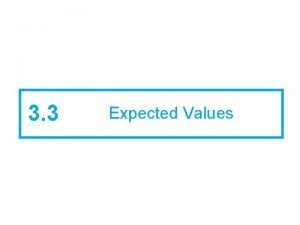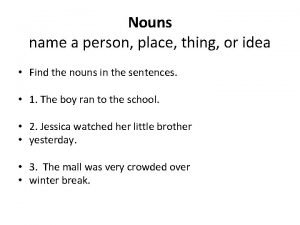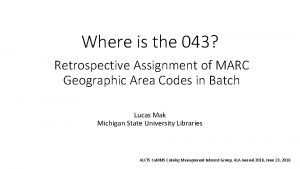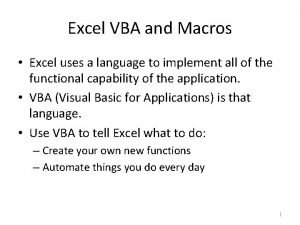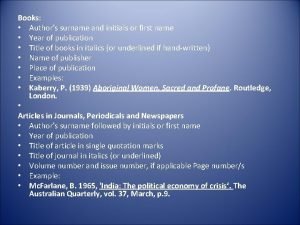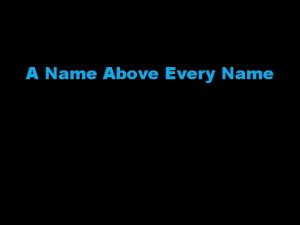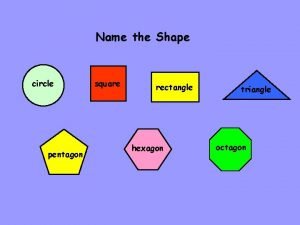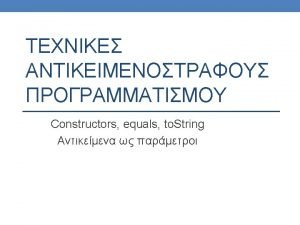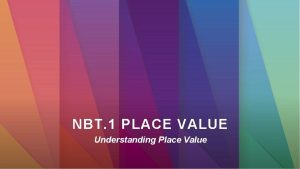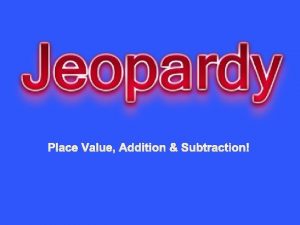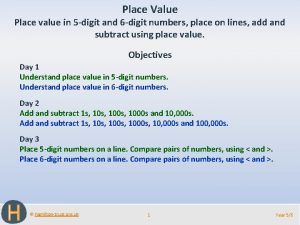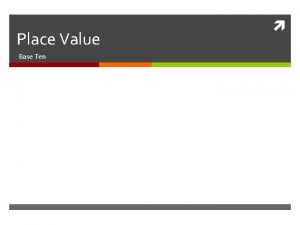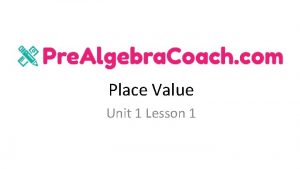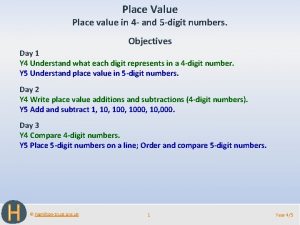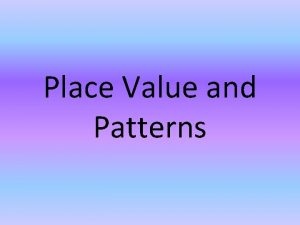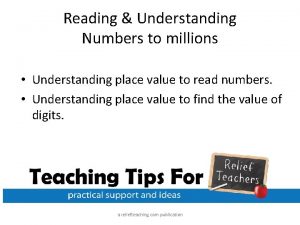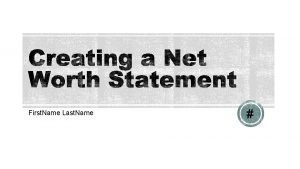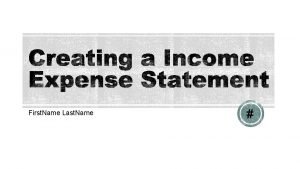Understanding Place Value Concepts Practice Name That Place





























































































- Slides: 93

Understanding Place Value

Concepts & Practice Name That Place & Value Whole Numbers Decimals Standard Form Whole Numbers Decimals Expanded Form Whole Numbers Decimals Compare and Order Whole Numbers Decimals Vocabulary Word First Definition First Rounding Whole Numbers Decimals

Place & Value Place Value means that the amount a digit is worth depends on its position in the number. On a place-value chart, you can think of numbers in groups of three. Organizing the digits of a number in a place-value chart helps you understand the number’s value. Let’s Take a Look…

Millions Ones Thousands , ,

By using the place value chart, we can determine the place and value of any digit within a number. 892409 , , Millions Thousands Ones So, in the number 892, 409, the place of the digit 2 is “Thousands” and the value is 2, 000.

Let’s try using the chart! 5743186 , , Millions Thousands Ones Whatis isthe theplaceof ofthe thedigit 4? 5? What is the value of the digit 6? Millions Ten-Thousands 6 Whatis isthe thevalueof ofthe thedigit 4? 5? What is the place of the digit 7? 5, 000 40, 000 Hundred-Thousands

Let’s practice without the chart! 234, 745 6, 098, 139 807 9, 008, 620 2, 391

THINK… What can I do to be sure I don’t make a careless mistake when trying to figure out a digit’s place and value?

Place & Value - Decimals Place Value means that the amount a digit is worth depends on its position in the number. This can be done with whole numbers and decimals. A decimal is a number expressed using a decimal point. Let’s Take a Look…

Whole Numbers The very important little decimal point Decimals

Don’t forget those “th”s in your Dethimals! If this represents a whole, or “one” then… This shows a ten. TH, because it takes 10 of them to make a whole This shows a hundred. TH, because it takes 100 of them to make a whole

Confused by decimals? Think of them like money… If this represents a whole, or “one” then… This shows a ten. TH, because it takes 10 of them to make a whole This shows a hundred. TH, because it takes 100 of them to make a whole

By using the place value chart, we can determine the place and value of any digit within a number. Decimals Ones What very important little thing is Yes! Our very important missing here? friend, the decimal point!

Write a decimal for the model shown. 2 4 Decimals

Write a decimal for the model shown. 8 Decimals

Write a decimal for the model shown. 1 2 Decimals

Let’s try using the chart! 8 3 7 2 Ones Decimals What is the value of the digit 8? Whatisisthe theplaceof ofthe thedigit 7? 3? 8 Hundredths Tenths What is the place of the digit 2? What is the value of the digit 7? Thousandths. 07

Let’s practice without the chart! 8, 139. 75. 328. 976 23. 81. 740

THINK… How can thinking of decimals in terms of money help me understand them better?

Standard Form simply means the number is shown in the usual way we write a number. For example, “two thousand, eight hundred and sixty one” in standard form is 2, 861! Simple enough! But beware of going to quickly and making a careless mistake!

Standard Form When we read numbers, it helps to think of them in the groups of three (periods) we use in our place value chart. The number “ 32, 567, 097” is read “thirty -two million, five hundred sixty seven thousand, and ninety seven”.

Try “reading” these numbers! 54, 235, 765 78, 090 999, 045 123, 405, 000 4, 000, 006 50, 013, 076 9, 007, 073

See if you can write these numbers in standard form! Nineteen thousand, Twenty million, Three million, sixty Three hundred one hundred fifty seventy two sixthree one seventy thousand, hundred two thousand, eighty nine

THINK… What do you think is the most common mistakes students will make when converting a number from words to standard form?

Standard Form - Decimals When we read numbers that have a decimal point, we read the whole number, then the decimal point as “and”, and finally the decimal. For example, the number 805. 45 is read “eight hundred five and forty five hundredths”. Students are tempted to say “point” instead of “and” so watch out for that! It’s not wrong, just tacky!

Try “reading” these numbers! 35, 463. 7 8. 879 67. 9 238, 004. 09 4, 000, 006 1. 876 64. 011 1, 234, 535. 5

See if you can write these numbers in standard form! Two hundred seventy Seventy five and fifty Three thousand eight and one Four hundred one hundredths seven and six tenths hundred thirty three and five thousandths

Expanded Form means writing a number as the sum of the value of its digits. Basically, you split the number up into the separate value of each digit and connect them with addition. Let’s Take a Look…It’s easier than it sounds!

342 in expanded form is: 300 + 40 + 2 23, 405 in expanded form is: 20, 000 + 3, 000 + 400 + 5 ***Notice in this example, there is a zero in the “tens” place, so we can just leave it out of our expanded notation!*** 607, 094 in expanded form is: 600, 000 + 7, 000 + 90 + 4 Ready to try some on your own?

Try “expanding” these numbers! 35, 765 78, 090 999, 045 123, 405, 000 4, 000, 006 205, 002 34, 661 50, 013, 076

THINK… What are some “tricks” for breaking a number into expanded form without making any careless mistakes?

Expanded Form with Decimals Expanded Form means writing a number as the sum of the value of its digits. You handle expanded form with decimals the exact same way you do with whole number—break apart each digit’s value and connect them with addition! Let’s Try a Few…

13. 875 in expanded form is: 10 + 3 +. 8 +. 07 +. 005 23. 405 in expanded form is: 20 + 3 +. 4 +. 005 ***Notice in this example, there is a zero in the “hundredths” place, so we can just leave it out of our expanded notation!*** 607. 094 in expanded form is: 600 + 7 +. 09 +. 004 Ready to try some on your own?

Try “expanding” these numbers! 305. 765 99. 945 4. 006 25. 002 123. 405 513. 076. 093 34. 661

Comparing Numbers Putting numbers in order from greatest to least or least to greatest is a skill you are guaranteed to use for the rest of your life. Just think: One day you might have to say “Wow! Last year I made $15, 023, 932 and this year I made $15, 203, 932!” It’s important to be able to rank and compare numbers. Let’s Explore…

How to Compare Numbers • First, remember the symbols we use to compare numbers: < less than, > greater than, = equal to What “tricks” did you use in the younger grades to remember these? • When we compare and order numbers, we always start from the digit on the left and move to the right—just like we read!

Memorize the “RULE” for place value: Line Up, Or Mess Up! If we were comparing the numbers 32, 624 and 32, 094 first we would line them up! Next, start from the left and compare each digit!

If we you are comparing 2 numbers that don’t have the same number of digits, you can always add a place holder zero if that makes it easier! Remember: Line them up, then start from the left and compare each digit!


Put these numbers in order from Least to Greatest! Before we even begin to tackle this, what do you think is the MOST common mistake students make on this type of problem?

Put these numbers in order from Greatest to Least!

Comparing Decimals • When we compare and order decimals we do it just like we do with whole numbers: we always start from the digit on the left and move to the right—just like the direction you read! • Don’t forget the golden rule of place value work: Line Up, or…

Remember, if the numbers you are comparing don’t have the same number of digits, you can always add a zero as a place holder! Remember: Line them up, then start from the left and compare each digit!


Put these numbers in order from Least to Greatest! Remember: The most common mistake students make is reversing the order of least to greatest and vice versa! Don’t fall in that trap! Check and re-check yourself!

Put these numbers in order from Greatest to Least!

Decimal A decimal number is a number that has a whole number part and a fractional whole number part. In general, the numbers to the left of the decimal point make up the whole part of the number, and the numbers to the right of the decimal point make up the fractional whole part of the number For example, the decimal number 658. 125 has a whole part of 658 and a fractional whole part of 125.

Decimal Point A dot written in a number that separates the whole number from the fractional part; it is read as “and”

Expanded Form Numbers broken up into their individual place values. (ie: 234 = 200 + 30 + 4)

Greater The number that is bigger in quantity or amount

Integer A member of the set of whole numbers and their opposites; Positive and negative whole numbers and zero; NOT fractions, decimals or mixed numbers … -3, -2, -1, 0, 1, 2, 3…

Less The number that is smaller in amount or quantity

Place Value The value given to the space a digit holds because of its place in the numeral

Rounding Replacing a number with an estimate of that number to a given place value

Standard Form A number written using digits

Whole Number A positive number without a fraction or decimal part

Decimal A decimal number is a number that has a whole number part and a fractional whole number part. In general, the numbers to the left of the decimal point make up the whole part of the number, and the numbers to the right of the decimal point make up the fractional whole part of the number For example, the decimal number 658. 125 has a whole part of 658 and a fractional whole part of 125.

Decimal Point A dot written in a number that separates the whole number from the fractional part; it is read as “and”

Expanded Form Numbers broken up into their individual place values. (ie: 234 = 200 + 30 + 4)

Greater The number that is bigger in quantity or amount

Integer A member of the set of whole numbers and their opposites; Positive and negative whole numbers and zero; NOT fractions, decimals or mixed numbers … -3, -2, -1, 0, 1, 2, 3…

Less The number that is smaller in amount or quantity

Place Value The value given to the space a digit holds because of its place in the numeral

Rounding Replacing a number with an estimate of that number to a given place value

Standard Form A number written using digits

Whole Number A positive number without a fraction or decimal part

Rounding When you “round” numbers, you are replacing the number with an estimate to a given place value. Rounding can help you simplify a problem in order to do mental math or get an estimate of your final answer. There are 3 simple steps…

Step 1 Underline the place to which you want to round. A word of caution: These steps might seem too “easy”, once you get used to rounding, but do them anyways! It will ensure that you don’t make a careless mistake!

Step 2 Circle the digit to the right of the underlined digit. Think of the circled number as a telescope directing you where to go next in the problem!

Step 3 If your circled digit is 0 – 4 the underlined number will stay the same. If the circled digit is 5 – 9 then the underlined number will go up one! All of the numbers to the right of the underlined number will turn to zeros!

Let’s Practice a Few! Round to the Tens Place Round to the Hundreds Place

Let’s Practice a Few! Round to the Tens Place Round to the Hundreds Place

Now, Your Turn! Round to the Tens Place Round to the Hundreds Place Round to the Thousands Place Round to the Ten Thousands Place

Rounding with Decimals Rounding with decimals is done exactly the same way you do it with whole numbers. Notice as we practice these next problems how important it is to know your places!

Step 1 Underline the place to which you want to round.

Step 2 Circle the digit to the right of the underlined digit. Think of the circled number as a telescope directing you where to go next in the problem!

Step 3 If your circled digit is 0 – 4 the underlined number will stay the same. If the circled digit is 5 – 9 then the underlined number will go up one! All of the numbers to the right of the underlined number will turn to zeros!

Let’s Practice a Few! Round to the Tenths Place Round to the Hundredths Place

Let’s Practice a Few! Round to the Ones Place Round to the Tenths Place

Now, Your Turn! Round to the Tenths Place Round to the Hundredths Place Round to the Ones Place Round to the Tenths Place

Which number has 4 in the hundred thousands place?

Which number has 6 in the thousandths place?

Which of the following shows thirty-two million, five hundred thirty-two thousand?

Which of the following shows eighty-nine and seventy-two hundredths?

Which number has 8 in the thousands place?

Which shows the numbers in order from least to greatest?

Which number is read seventyone and eighteen hundredths?

Which of the following is true?

Which of the following is true?

How is the number 412, 030 read?

What is 35. 042 rounded to the nearest ten?

What is 5. 892 rounded to the nearest tenth?

What is 253. 765 rounded to the nearest hundredth?
 Phân độ lown
Phân độ lown Block xoang nhĩ là gì
Block xoang nhĩ là gì Thể thơ truyền thống
Thể thơ truyền thống Thơ thất ngôn tứ tuyệt đường luật
Thơ thất ngôn tứ tuyệt đường luật Walmart thất bại ở nhật
Walmart thất bại ở nhật Tìm vết của đường thẳng
Tìm vết của đường thẳng Hãy nói thật ít để làm được nhiều
Hãy nói thật ít để làm được nhiều Tôn thất thuyết là ai
Tôn thất thuyết là ai Gây tê cơ vuông thắt lưng
Gây tê cơ vuông thắt lưng Sau thất bại ở hồ điển triệt
Sau thất bại ở hồ điển triệt Place place value and period
Place place value and period Value creation value delivery value capture
Value creation value delivery value capture Understanding essential computer concepts
Understanding essential computer concepts Understanding core database concepts
Understanding core database concepts Name all the lines
Name all the lines Practice a understanding points lines and planes
Practice a understanding points lines and planes Pricing understanding and capturing customer value
Pricing understanding and capturing customer value Topics for value education
Topics for value education Professional nursing practice: concepts and perspectives
Professional nursing practice: concepts and perspectives Professional nursing practice concepts and perspectives
Professional nursing practice concepts and perspectives Cost-benefit analysis concepts and practice
Cost-benefit analysis concepts and practice Pricing concepts for establishing value
Pricing concepts for establishing value Practice assessor and practice supervisor
Practice assessor and practice supervisor Tiverton castle place
Tiverton castle place Transfer transfer
Transfer transfer A disturbance that transfers energy from place to place
A disturbance that transfers energy from place to place 5-8 practice graphing absolute value functions
5-8 practice graphing absolute value functions 5-5 skills practice inequalities involving absolute value
5-5 skills practice inequalities involving absolute value Absolute value inequalities and vs or
Absolute value inequalities and vs or Npv meaning
Npv meaning Funfair bgg
Funfair bgg Place value of 865
Place value of 865 Decimal place value
Decimal place value Pictorial models of geometric figures with no labels
Pictorial models of geometric figures with no labels Place value symbols
Place value symbols Place value and
Place value and 6561/729
6561/729 Place value through thousandths
Place value through thousandths Place value street story
Place value street story Write the place value of the underlined digit
Write the place value of the underlined digit Place value drawing
Place value drawing Place value jeopardy
Place value jeopardy Place value gcse foundation questions
Place value gcse foundation questions Indian place value chart class 5
Indian place value chart class 5 Place value periods
Place value periods Place value of decimals
Place value of decimals White rose block 4
White rose block 4 Place value of 5 digit numbers
Place value of 5 digit numbers Whole numbers chart
Whole numbers chart 449 019 rounded to the nearest hundred thousand is
449 019 rounded to the nearest hundred thousand is Place value chart eureka math
Place value chart eureka math Tenths place
Tenths place Rounding decimals jeopardy
Rounding decimals jeopardy Add the place value of 3 in 235 to 150
Add the place value of 3 in 235 to 150 Place value detectives
Place value detectives Page 46
Page 46 Place value of 246
Place value of 246 Place value park
Place value park Rounding with a number line
Rounding with a number line Millionths place value
Millionths place value Expanded form
Expanded form Lesson 6 understand decimal place value
Lesson 6 understand decimal place value Rounding jeopardy
Rounding jeopardy Decimal places names
Decimal places names Place value choice board
Place value choice board What is 264 rounded to the nearest ten
What is 264 rounded to the nearest ten How many ones are in 200
How many ones are in 200 Place value jeopardy
Place value jeopardy Decimal place value test
Decimal place value test Place value of the digit 8 in 809 is
Place value of the digit 8 in 809 is Round up two decimal places
Round up two decimal places Place value of 234
Place value of 234 Place value and estimating
Place value and estimating 574 in expanded form
574 in expanded form 5th grade math review jeopardy
5th grade math review jeopardy Value received and value parted with
Value received and value parted with How to find p value from t statistic
How to find p value from t statistic D value and z value
D value and z value Ester value principle
Ester value principle Present value vs future value
Present value vs future value Relative value vs absolute value
Relative value vs absolute value What is the value of what is the value of
What is the value of what is the value of What is the value of what is the value of
What is the value of what is the value of Anthropocentrism examples
Anthropocentrism examples Capturing value from customers
Capturing value from customers Practice name examples
Practice name examples Person place thing idea
Person place thing idea Contoh kalimat public places
Contoh kalimat public places Marc geographic codes
Marc geographic codes Sheet name = cell value
Sheet name = cell value Authors last name first name initial
Authors last name first name initial Name above every other name
Name above every other name 5 sided shape
5 sided shape Public string name
Public string name












